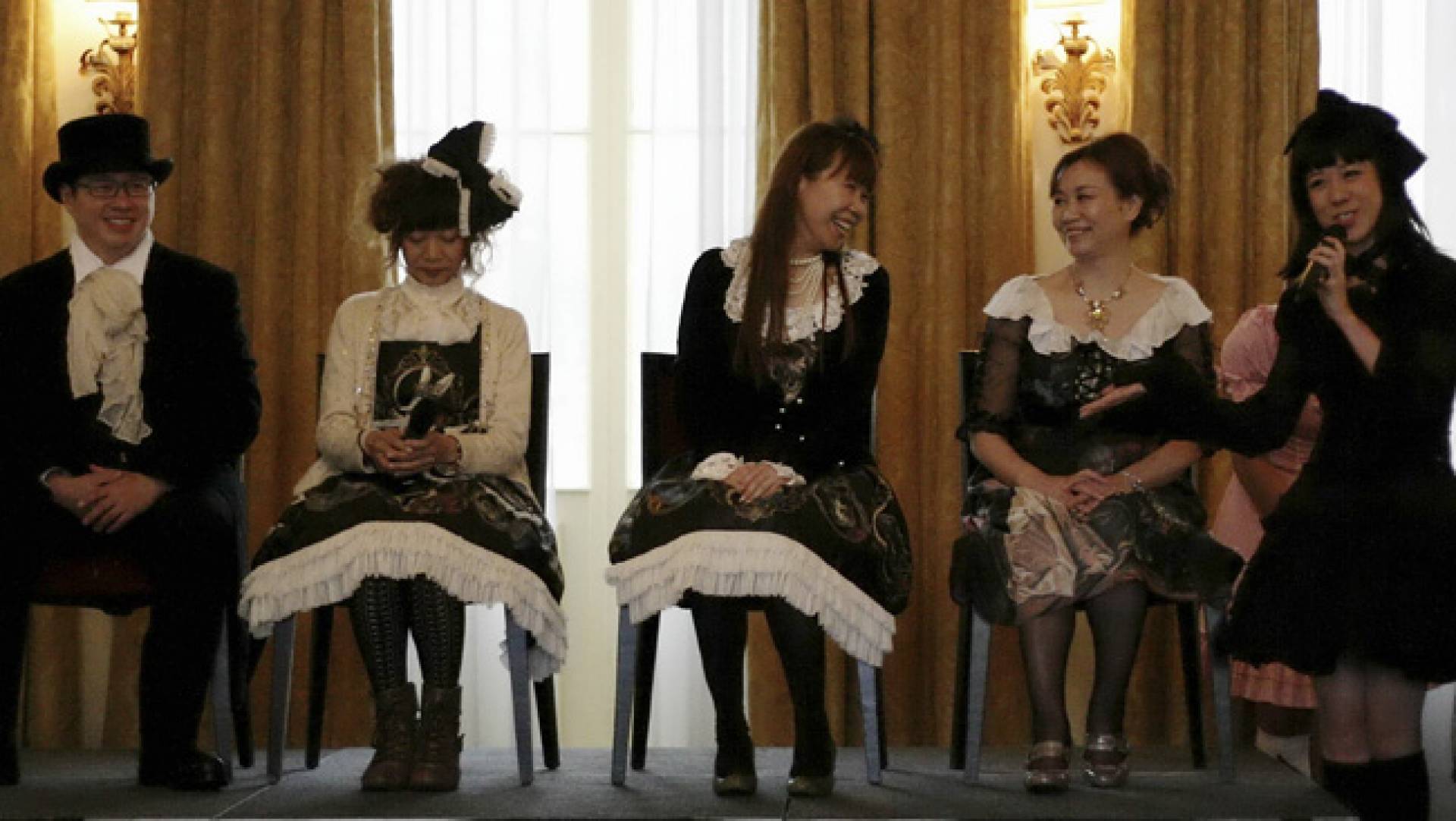How important are rules in lolita fashion? Why are there no dark skinned models? When are you too old to wear lolita? Read on to find out.
On the 8th and 9th of September 2012, The Tea Party Club, a community of British lolitas that organises meetups and events, celebrated its 5th anniversary by hosting the UK's first ever brand party at the Charing Cross Hotel in London. One of the highlights of the two-day event, which drew lolitas from all over the world, was a Q&A panel with guests from Japan: Mari Nakamura, head designer of the classic lolita brand Juliette et Justine, Mariko Suzuki, editor of the Gothic and Lolita Bible, internationally renowned doll maker Koitsukihime and makeup artist Akira Tanaka of Tony's Collection Inc.
I just started my own business. How difficult was it to set up your own brand?
Mari Nakamura: It wasn't that very hard. I wish you the best of luck!
Mari Nakamura, you originally started at Victorian Maiden. Is that right?
Mari Nakamura: Yes, that's right.
Why did you decide to set up your own brand?
Mari Nakamura: I had a fight with the head designer.
Is there a particular period in history that inspires Juliette et Justine more than others?
Mari Nakamura: I like the 16th and 17th century best.
Koitsukihime, what are your inspirations, and have you always liked dolls or was it a recent development later in life?
Koitsukihime: It has been 30 years since I started making dolls.
Koitsukihime, you collaborated with Baby the Stars Shine Bright. Do you have any other plans to collaborate with lolita companies?
Koitsukihime: I am thinking about it. (Gestures to the other guests.) They are hoping there will be a Juliette et Justine collaboration.
This question is for all four of you. What is your favourite style of lolita?
Mari Nakamura: I like classic lolita the most.
Mariko Suzuki: I like all of them.
Tony Tanaka: As a makeup artist, I like doing makeup for sweet lolita the best.
Koitsukihime: I like gothic lolita.
Akira Tanaka, what inspires you?
Akira Tanaka: I look at the model and I think about how to work with that individual person.
Suzuki-san, apart from Juliette et Justine, what is your favourite lolita brand that you feature in the Gothic & Lolita Bible?
Mariko Suzuki: I can't choose because I think I like them all.
This is a question for everyone. What is your style in everyday life?
Mari Nakamura: I mainly wear Juliette et Justine.
Mariko Suzuki: I usually wear Victorian style blouses and I also like one-piece dresses.
Akira Tanaka: Usually I wear a suit that is easy to move around in.
Koitsukihime: Normally, because I make dolls, I have to wear normal clothes or a white work coat, but when I go out I wear gothic style clothing.
Nakamura-san, how do you choose the artwork for a print? Is it a favourite piece of art?
Mari Nakamura: Usually I pick an artwork depending on the inspiration I had. I actually never had a problem picking a piece of art.
How did you come up with the name Juliette et Justine?
Mari Nakamura: It is from a novel by a French author. (NB: "Justine or The Misfortunes of Virtue" by the Marquis de Sade) I also had an ideal woman in mind and that is how I named the brand.
I have a question for Suzuki Mariko. I wrote a diploma thesis about the rules and culture as shown in the Gothic & Lolita Bible. Now there are 45 issues and there are still many rules in there. How important are rules to the Gothic & Lolita Bible and to lolita?
Mariko Suzuki: I personally believe that you can make up your own rules.
Koitsukihime, I noticed that some of your dolls look very happy while others seem more tortured. I was curious what the thought process was behind these two very different moods that you put into them or maybe their personalities?
Koitsukihime: I get asked this question quite often. The dolls I make are not playthings; they are not something you would give to a child to play with, so therefore I think that these dolls should express the soul more. Therefore I have put an expression on them that will evoke an emotion from the person who is looking at them, so it is better if they look less happy.
Nakamura-san, you told us which eras of paintings you like, but what influenced you to use paintings for lolita clothes to begin with?
Mari Nakamura: I feel that clothing is the number one thing to protect or cover your soul, so if you have a masterpiece around your body then that it something that will help you become more beautiful and elegant.
This is a question for everyone. How often do you have an opportunity to use original Victorian or Edwardian clothes in a shoot, using both lolita brands and original items?
Mari Nakamura: I do use vintage products in my shoots, but because my clothes are still tailored in a modern way, I only use a little bit so they don't clash too much. If you use a lot of vintage it sometimes does clash.
This is a question for Nakamura-san and Suzuki-san. Is one ever too old to wear lolita?
Mariko Suzuki: (laughs) There probably is an age.
Mari Nakamura: I like to think that my brand is for older people and I want people to wear it for a longer time. After all, romance and elegance are the main points of lolita, aren't they?
Mariko Suzuki: There is no problem with gaining in years. That is fine. There are a lot of people who are older and who are very lovely.
My question is for the editor of the Gothic & Lolita Bible. What is your favourite part of the magazine? Is it the street snaps, the makeup tutorials, the models or the photo shoots?
Mariko Suzuki: Because my job is very close to the main editor, my job is to put everything together, so the whole product itself is what I like best.
I have a question that is for everyone, but particularly for Nakamura-san and Suzuki-san. What is your opinion on how lolita has spread to the Western community, and do you feel it is important to know that we have different features when it comes to styling?
Mariko Suzuki: I was very shocked when about 7 years ago I found out that there were lolitas outside Japan, but I am extremely happy that people are interested in this fashion. Actually, lolita is a fashion where Japanese people pretend to be Western, therefore everyone here who is not Japanese is probably far more authentic.
Akira Tanaka: The main thing I think is that I am asked to make girls look very doll-like. I think if you aim to look like a bisque doll then probably that is the best way to do your makeup.
Mari Nakamura: 40% of my customer base is actually overseas. I think that's very good and actually that's fine.
Koitsukihime: The expression on my dolls is usually from Western artwork and things like that, so when I see everyone looking very beautiful I am very pleased about it.
I have a hair and makeup question—it is in two parts. Firstly, when it comes to the application of makeup, would you suggest that makeup creates the look or that it is simply there to enhance the look that is created through the dress? Secondly, slightly more straightforward, do you have any recommendations for putting in curls that will stay there?
Akira Tanaka: Probably the best way is that while you have the curling irons in, keep them there and spray the hair with hair spray. Then slowly pull them out and let it set. As for the other question, the clothing is the important point of lolita, so obviously you have to coordinate your makeup to go with it.
A minute ago we were saying how lolita is now an international phenomenon. As an Asian lolita, I feel it would be nice to see lolitas of different ethnicities, but there seem to be mostly very fair skinned lolitas featured on websites, in magazines and on dolls as well. Would you consider appealing more to the international market by having models and dolls of different skin colours?
Mari Nakamura: I do have every intention to use people of darker skin. However, the models that come to Japan are usually Caucasian and very pale. Hands up anyone who fits that description and wishes to be a model!
I have got a question for all of the guests. Could you describe in one phrase what lolita fashion really means to you?
Mari Nakamura: It's my job!
Band: To me it is destiny.
Akira Tanaka: As a man, I think it is something about politeness and something that is very soothing to look at.
Koitsukihime: To me it is a philosophy.
Juliette et Justine may be a bit of an exception, given that 40% of the customer base is western, but I would like to know generally how the Japanese perceive the Western market and whether there is going to be more of a movement towards appealing to us?
Mari Nakamura: I don't know for sure about the other brands, but seeing things like Japan Expo, where a lot of brands do come and have tables, I think there probably is a will to expand.
This is something that has been asked a lot on the event page: we are all very different sizes, so would you consider making a size 0 and a size 3? (NB: Currently Juliette et Justine only produces size 1 and 2)
Mari Nakamura: I am considering it and I will definitely think a little bit more about everyone's sizes from now on to accommodate more people.
Would you consider either setting up a shop or selling your clothes somehow in the UK?
Mari Nakamura: Could you ask the buyers of all the shops to stock my products? I want to do it, but I need to find someone who will carry them. Right now, if you apply you might be able to do it!
As the partner of a lolita, I am curious about what your partners think of the whole fashion and lifestyle?
Mari Nakamura: Well, I am single. But I think if they like me then there shouldn't be a problem. I mean, isn't it cute?
Mariko Suzuki: My husband often looks like he wants to say something about it, but he doesn't.
Akira Tanaka: As I said before, I think it is soothing and beautiful to look at, so I think there is no problem with girls pursuing cuteness.
Koitsukihime: Actually, I would like a boyfriend who would suit lolita.
Japan has a lot of different styles going on. I am wondering if there are any other styles that you like in the streets beyond lolita, such as mori or dolly?
Mari Nakamura: Not really.
This is a question for the hair and makeup artist. Do you think it is better to use wigs or your natural hair with lolita?
Akira Tanaka: You get more volume with a wig, don't you, and it will change your whole face, so I think that is better.
Even if it looks unnatural?
Akira Tanaka: Well, these days there are wigs that look very natural.
This is a question for the editor of the Gothic & Lolita Bible. I know that the publishing industry and book shops have had a lot of trouble lately and moved into areas such as e-books and websites. I was wondering if that is something that you think you may face in the future or would consider doing?
Mariko Suzuki: No, never.
Nakamura-san, you mentioned earlier about maybe doing a collaboration with ball-jointed dolls. Have you ever considered making small dresses for SDs or MSDs and maybe doing a photo shoot that way?
Mari Nakamura: If there was an order I might.
Are there any major differences between the Western lolitas and the Japanese lolitas?
Mari Nakamura: The coordinates of Western lolitas are very different from those of Japanese lolitas, and colour-wise they stand out more. I think that's very cute.
Did our appearance surprise you? Are we what you were expecting?
Mari Nakamura: It is just as I imagined. Everyone looks amazing and I am really impressed with everyone.
Is there anything that as a lolita you should never do or never wear?
Mari Nakamura: If you don't like it, don't wear it. You have to enjoy what you wear.
Mariko Suzuki: However, please don't cross your legs and smoke at the same time.
How old were you when you got into lolita fashion?
Mariko Suzuki: Lolita fashion was founded roughly around 1998 and that was the first time that I came into contact with it.
Mari Nakamura: When I was 15 or 16 I started to see lolitas in the street and that is how I got into the fashion. 5 years after that, I had founded my own company.
Koitsukihime: Before gothic lolita was even invented or became a scene, I was always wearing gothic black lace clothing, so that is when I started getting into it. But I can't tell you how old I am!
Is there anything you would like to ask us as Western lolitas?
Mari Nakamura: How did you guys find out about lolita?
Lolita 1: I discovered ball-jointed dolls about 2006 and saw them wear lolita fashion. That is what made me want to wear it.
Lolita 2: My brother actually got me into the fashion. My oldest brother told me about it when I was about 12 or 13, but I brushed it off. Recently he mentioned it again and so I did some research and got my first lolita dress.
Mari Nakamura: You have got a very good brother!
Lolita 3: My best friend was into lolita and she came to my house dressed in white wa-loli, so I got into it through that.
Mari Nakamura: You have a very good friend!
Mariko Suzuki: I am extremely impressed with everyone's coordinates, makeup and hair today and I was wondering: how long did it take for you to get ready?
Lolita 4: 3 months!
Lolita 5: 2 hours.
Lolita 6: I woke up at 8am and left about 11am.
Lolita 7: I woke up at 6am and left at 8am.
Lolita 8: Four hours!
Lolita 9: I got up at 7.30am and I was here by 11.30am. I also spent several hours yesterday preparing my accessories, so that's probably 10 hours in total.
Lolita 10: 40 minutes—I don't have a lot of patience.
Lolita 11: 10 minutes!
Mariko Suzuki: Has anyone else taken 10 hours?
Lolita 11: I spent several weeks making dresses.
Lolita 12: I took 2 months and then 14 hours to make everything.
Mariko Suzuki: Can anyone guess how long it took us to get ready?
Lolita 13: 3 hours!
Mariko Suzuki: A very short time.
Lolita 14: An hour?
Lolita 15: 20 minutes?
Mariko Suzuki: We were very busy with a photo shoot this morning. We just threw on our dresses and put some stuff in our hair and we already had makeup on. It took 15 minutes. (Applause.)
JaME would like to thank Kyra Bown and The Tea Party Club for making this opportunity possible.
___________________________________________________________
The questions and answers of the Q&A have been transcribed as faithfully as possible. Should we have misunderstood or omitted any details we apologize.

![HYDE [INSIDE] LIVE 2024 -EXTRA- at Makuhari Messe](https://www.jame-world.com/media/image/2024-11/_16-9_14951.jpg)



